Direct coronal restorations of hard dental tissue loss during the pregnancy period, using resin composites, present a number of characteristics related to the physiological condition of the female patient. In this respect, the main objective is the achievement of a correct, long-lasting obturation, but with a minimal operator stress. “Stamp technique” is an easy and effective odontal treatment that leads to a perfect morphological and functional restoration without requiring additional occlusal adjustments.
Restaurarea cu răşini compozite prin „stamp technique” în sarcină – prezentare de caz
Stamp technique for direct resin composite restoration in pregnancy – case report
First published: 27 decembrie 2018
Editorial Group: MEDICHUB MEDIA
DOI: 10.26416/Gine.22.4.2018.2145
Abstract
Rezumat
Restaurările coronare directe ale pierderilor de ţesut dur dentar, utilizând răşini compozite, în perioada de sarcină, prezintă particularităţi de tratament condiţionate de situaţia fiziologică a pacientei. În acest sens, principalul obiectiv îl reprezintă realizarea unei obturaţii corecte, cât mai longevive, dar în condiţiile unui stres operator minim. „Stamp technique” reprezintă o modalitate uşoară, eficientă, de tratament odontal care conduce la realizarea unei restaurări perfecte din punct de vedere morfologic şi funcţional, fără a necesita ajustări ocluzale suplimentare.
Introduction
The need for coronary restoration treatments for dental tissue loss, which are most commonly through carious lesions, is, along with pregnancy gingivitis, the main cause of pregnant women’s presentation in the dental office(1). During pregnancy, dental therapeutic maneuvers are tributary to the physiological condition of the woman, so they must meet a number of special requirements, as follows: a minimally invasive and conservative approach with as few treatment sessions as possible; within them, the working time is desirable to be limited, with frequent breaks, less tiring and less stressful for the pregnant patient. At the same time, it is necessary that the coronal restorations performed during pregnancy show adequate longevity in the oral cavity(2,3).
Resin composites have become highly used direct restoration materials in the posterior area, being designed to meet particular requirements in terms of both biomechanical strength and accurate reproduction of dental structures, exhibiting aesthetic appearance(4). The methods of inserting composite resins are different, depending on the clinical situation, among them the stamp technique or the micro-brush stamp technique being one of the most known and used(5).
This is a simple and rapid technique of direct restoration of the occlusal anatomy by making a copy (impression or stamp) of the occlusal morphology of the unprepared tooth(6). This method can be used in restoring teeth affected by the carious process, as long as the morphology of the tooth is intact. The materials used for impression of involved area are the low viscosity composite and the rubber dam liquid(7,8).
Case report
In this paper we present a method of direct coronary restoration, with resin composite materials, of a dental caries at tooth 46 in a 17-week pregnant woman, who was 24 years old (Figure 1).
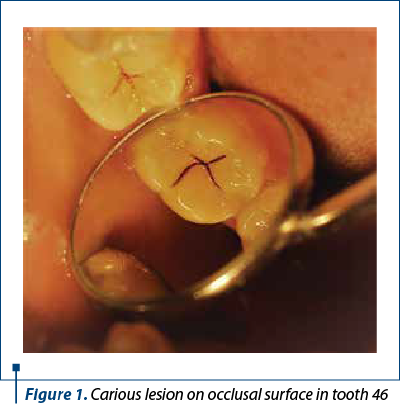
The clinical exam revealed the presence of the carious lesion in the occlusal pits and grooves, having a limited extension and showing minimal structure changes. As a result, the tooth restoration was made using stamp technique because the carious process was superficial.
In choosing this method of treatment, we first considered the physiological condition of the patient’s pregnancy, which implies the need for a less invasive restoration method, a shorter working interval and the minimization of operator stress.
The treatment steps were as follows: removing the dental plaque with professional brushing, followed by the application of a small amount of lubricant to the occlusal face to vaseline the surface in order to allow the polimerizated impression material to detach easily.
For the realization of stamp technique, rubber dam liquid (Rubber dam liquid, Cerkamed®) was applied to the occlusal surface of the tooth to be prepared and subsequently to be restored (Figure 2). The rubber dam liquid is a light-cure product based on resins and inorganic excipients which, in the case of this technique, is used similarly to a dental impression material, replicating the occlusal surface configuration entirely.

To manipulate the stamp, an applicator was immersed into the rubber dam liquid without touching the dental surface beneath the material, then the dam liquid was light cured. The applicator will act as an impression handle (Figure 3).
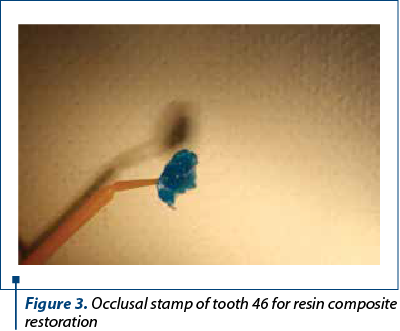
The next stage of the treatment consisted in the completely removal of hard dental tissues affected by carious process and the preparation of a class I cavity for adhesive materials with internal rounded angles (Figure 4).
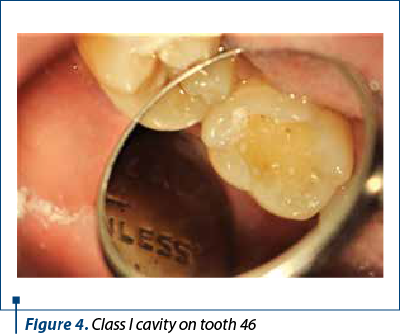
In order to insert the restorative resin composite material (Filtek™ P60, 3M ESPE), the tooth was isolated for obtaining a dry working field and the cavity was cleaned with 2% chlorhexidine; then the specific dental adhesion stages were achieved: acid etching in the total etch technique with 37% orthophosphoric acid (Alpha Etch-37R); after washing and drying the cavity, the adhesive system was applied and light cured (Figure 5 and Figure 6).
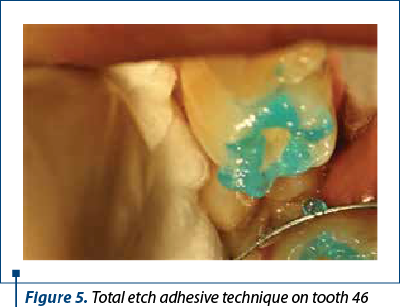
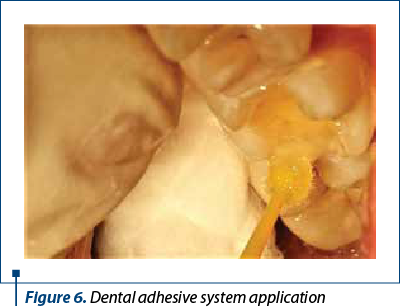
The next step was to insert the composite resin into the prepared cavity over which a teflon tape was applied as a separation medium prior to light cure polymerization (Figure 7).
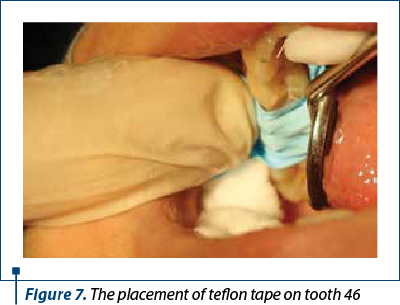
The occlusal stamp, previously done, was firmly placed over the teflon tape to achieve the morphological configuration corresponding to the initial situation of occlusal surface, then it was removed and the resin composite light cured for 30 seconds (Figure 8 and Figure 9).
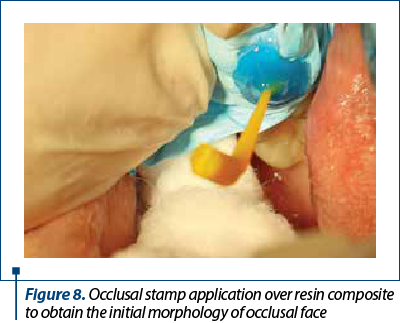
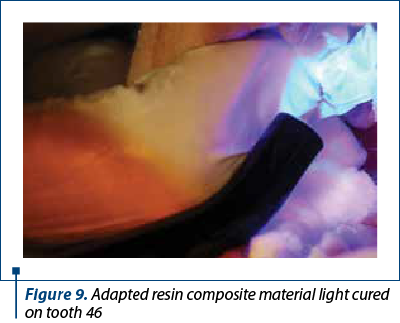
The major advantage of this technique is that it allows an accurate reproduction of the occlusal surface, so that functional adaptation with respect to antagonistic teeth is no longer required (Figure 10). The final stage of adjusting occlusion of the restoration using the rotary instruments as diamond burs is eliminated, and only slight finishing and polishing are necessary, using polishing gums.
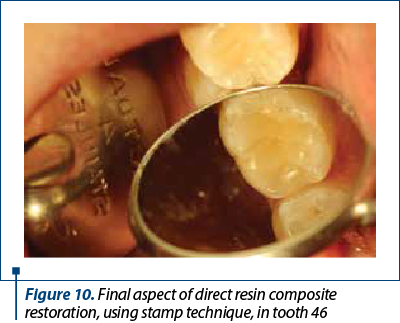
Conclusions
For direct resin composite restorations with limited substance loss in female patients during pregnancy, stamp technique is an ergonomic, simple and less time-consuming technique with a predictable result, the anatomy of involved surface being easily achieved thanks to the initial stamp, conditioned by an intact occlusal face(9).
Acknowledgements: For this article, all the authors have equal contributions.
Conflict of interests: The authors declare no conflict of interests.
Bibliografie
- Gheorghiu IM, Mitran M, Mitran L, Pană DP, Mironiuc-Cureu M. Gingivita de sarcină. ORL.ro, nr. 14(1), 2012;42-3.
- Otomo-Corgel J. Dental management of the female patient. Periodontology. 2013; 61:219-31.
- Gheorghiu IM, Perlea P, Ciolan CG, Mitran L, Suciu I, Mitran M. Restaurarea coronară directă cu pivot din fibră de sticlă în sarcină - prezentare de caz. Ginecologia.ro. 2017;18:62-5.
- Rasines Alcaraz MG, Veitz-Keenan A, Sahrmann P, Schmidlin PR, Davis D, Iheozor-Ejiofor Z. Direct composite resin fillings versus amalgam fillings for permanent or adult posterior teeth. Cochrane Database Syst Rev. 2014; (3):CD005620.
- Duque C, da Silva RC, dos Santos-Pinto L. Treatment options for the occlusal surface of first permanent molars. J Clin Pediatr Dent. 2004;29:5–9.
- Perrin P, Zimmerli B, Jacky D, Lussi A, Helbling C, Ramseyer S. The stamp technique for direct composite restoration. Schweiz Monatsschr Zahnmed. 2013;123 (2):111-29.
- Alshehadat SA, Halim MS, Carmen K, Fung CS. The stamp technique for direct Class II composite restorations: A case series. J Conserv Dent. 2016;19(5):490-3.
- Kilian Molina. Direct Posteriors, Cases, Shadeguides, Stamp technique. Part 1.
- http://www.styleitaliano.org/stamptechnique-part-1;2016.
- Mary G, Jayadevan A. Microbrush stamp technique to achieve occlusal topography for composite resin restorations. A technical report. J Sci Dent. 2016; 6 (2):76-82.
Articole din ediţiile anterioare
Coagularea intravasculară diseminată produsă la domiciliu în al treilea trimestru al sarcinii - două cazuri clinice
Coagularea intravasculară diseminată (CID), asociată sarcinii şi naşterii, este un eveniment rar, cu evoluţie potenţial fatală; studiile indică o i...
Tuberculoza pulmonară în sarcină
Tuberculoza (TB) rămâne, la nivel global, o cauză importantă de mortalitate şi morbiditate în sarcină, fiind în directă legătură cu endemia infecţi...
Leziunile CIN de grad înalt în sarcină şi post-partum: o asociere rară. Noutăţi în abordare
Scopul acestei lucrări este de a reevalua oportunitatea terapiei leziunilor CIN 2/3 diagnosticate în cursul sarcinii, pentru a evita progresia a...
Managementul sarcinii asociate cu transplant renal şi infecţie cu SARS-CoV-2 – prezentare de caz
Sarcinile asociate transplantului renal implică deseori complicaţii materno-fetale. Riscul de preeclampsie, moarte fetală intrauterină sau de o...